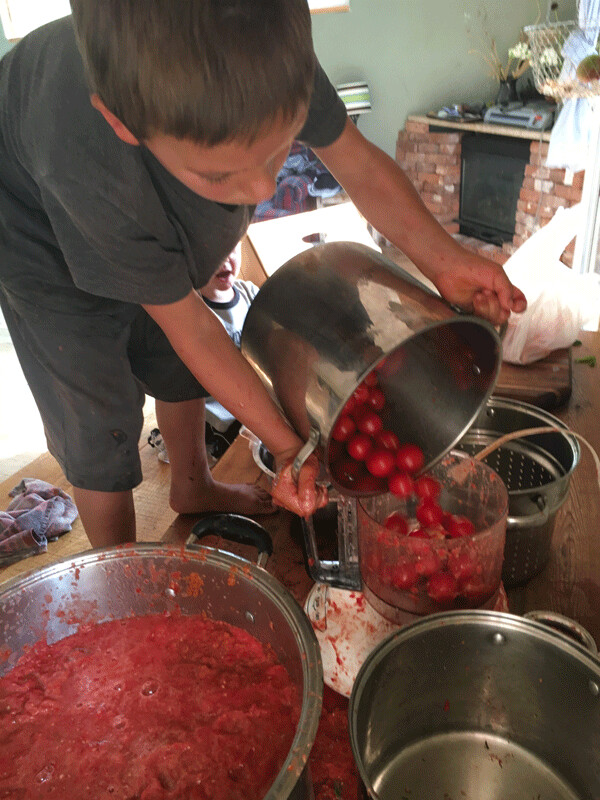News & Articles
Browse all content by date.

I learned about salsa from a used car salesman. That may sound sketchy, but Roy had already given me a great deal on a Subaru. Then he gave me a quart of salsa for Christmas. By the time he told me that salsa helped him quit drugs in the 1970s, I already knew Roy was not your average used car salesmen. So when he invited me over to watch football and make salsa, I jumped at the chance. And not because the Broncos were playing.
Roy looks like Willie Nelson and speaks with a southern twang. That afternoon, he laid out a murderous lineup of hot peppers, as well as some bells and sweeties. They would add spice, sweetness and pungency to the tomatoes, carrots, garlic, onion and cilantro, all of which, peppers included, are ripe at about the same time. With 20 gallons of salsa to make, we pulled on gloves and got to work.
Since learning what I learned that afternoon, I have been making Roy-style salsa, albeit with more reasonable levels of capsicum. His salsa can do almost anything, and it changed my life too, if differently than how it changed Roy’s.
The extremely high levels of hot pepper heat helped Roy with his addiction, he told me, by triggering a rush of endorphins that took the place of the endorphins heroin triggered. When he feared falling off the wagon, Roy fell into the spicy arms of his salsa instead.
For me, Roy’s salsa has become a glue-behind-the-glitter type ingredient in my cooking that I use in a ton of sneaky ways. Salsa is also a way of dealing with overwhelming mountains of summer produce. When converted into salsa and sealed into gleaming jars, that summer bounty is preserved at its peak. It is summer in a jar, and it can flavor the menu all winter long.
When I’m looking to add a little je ne sais quoi to a dish, practically any dish, the range of vegetable flavors in a jar of Roy-style salsa can often get it done. It could be stew, eggs, coconut curry, potatoes and many other dishes that don’t necessarily scream tomato. The salsa adds aromatic complexity, on par with adding a good vegetable stock, but with spice and acid too.
Because I use the salsa in so many ways, I keep the heat level mild. There are many ways to add chile spice at serving time, if and when you are looking for some hot salsa for your corn chips and whatnot.
One day each summer, I spend an afternoon with the kids using the food processor and seasonal veggies to convert the kitchen into a canvas for Jackson Pollock-style splatter painting. We chop, blend and boil a vat of our own, and funnel it into clean, sterile jars that seal on the countertop. Stored in a reasonably cool place, these jars will last until next summer and beyond. In the fridge, an open jar can last two weeks before going bad.
I shouldn’t publish Roy’s recipe, as food safety experts say it’s too dangerous. Not because of the insane levels of heat, but because Roy’s salsa doesn’t have enough acid. Once, a few years back, I did print the recipe. And the food safety experts swarmed.
The issue is that tomatoes, while acidic, are barely acidic enough to bring pH of most types of salsa below 4.5. And some tomatoes are more acidic than others. So, adding vinegar is advised--as much as a cup or more for each quart of salsa, which makes the salsa roughly 25 percent vinegar. That is more acid than Roy would joke about, even when talk turned to the good ole’ days.
Until recently, I have quietly resisted adding extra acid to my salsa. As long as the jar is sealed, the salsa inside has been good. Now I add a little, maybe a quarter of what the food safety experts recommend. And not long ago, I came across a recipe that bears a striking resemblance to Roy’s, but without any safety violations whatsoever.
I can say that with confidence because the recipe, for Carrot Pepper Salsa, comes from the Ball Complete Book of Home Preserving, published by Ball Company, which has been making mason (canning) jars since 1884. The only difference between this recipe and Roy’s is the use of vinegar and sugar. Perhaps the Ball recipe was a source for Roy when he formulated his own. Anyway, the quantities below are straight out of the book, so please direct any complaints or legal action to the Ball Corporation.
Ball Jar Carrot Pepper Salsa
While the quantities listed below are exactly from the book, I have tweaked the method in a Roy-esque direction, by using the food processor. But the cooking and canning times are by the book.
makes five cups of salsa
6 cups chopped tomatoes
3 cups coarsely grated peeled
carrots
1½ cups cider vinegar
1¼ cups brown sugar
½ cup chopped onion
½ cup chopped, seeded jalapeno
peppers
1½ teaspoons salt
½ teaspoon freshly ground black
pepper
¼ cup finely chopped cilantro
Use a food processor to mince the tomatoes, carrots, onions and peppers. Add those ingredients to a heavy bottom pot, along with the salt, pepper, sugar and vinegar, and bring to a boil on medium/high heat, stirring often. Reduce heat and simmer for an hour. Stir in the cilantro and cook for five more minutes.
Using a ladle and funnel, add the salsa to clean, sterile jars, leaving an inch of head space at the top. Place the lids and screw on the rings, and process for 15 minutes in a boiling water bath. Listen for the pings of sealing jars. It’s the sound of summer, stashed away for later.

| Tweet |


